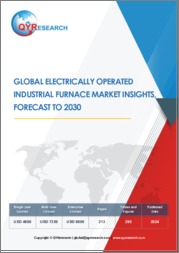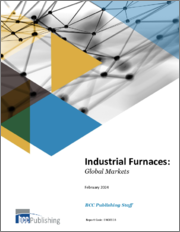
|
시장보고서
상품코드
1819926
산업용 노 시장 보고서 : 노 유형, 어레인지먼트, 최종 용도, 지역별(2025-2033년)Industrial Furnaces Market Report by Furnace Type, Arrangement, End Use, and Region 2025-2033 |
||||||
세계 산업용 노 시장 규모는 2024년 144억 달러에 달했습니다. 향후 IMARC Group은 2033년에는 217억 달러에 달하고, 2025-2033년 4.4%의 연평균 성장률(CAGR)을 보일 것으로 예측했습니다. 제조업의 확대, 고품질 철강 및 알루미늄에 대한 수요 증가, 급속한 기술 발전, 에너지 효율에 대한 규제 압력, 항공우주 및 방위 산업의 성장, 지속 가능한 관행으로의 전환 등이 시장 성장을 가속하는 요인 중 일부입니다.
산업용 노 시장 동향 :
제조업의 확장
신흥 지역의 제조업 확대는 시장 성장을 가속하는 주요 요인 중 하나입니다. 산업용 노 시장 예측에 따르면 2022년 중국의 제조업 생산액은 약 4조 9,756억 1,000만 달러로 2021년 대비 약 1.36% 증가할 것으로 예측됩니다. 중국, 인도, 브라질 등의 산업화에 따라 제조 공정의 다양한 요구를 충족시키기 위해 대용량 산업용 노에 대한 수요가 증가하고 있으며, 이는 시장 성장을 더욱 촉진하고 있습니다. 산업용 노 시장 가치는 자동차, 건설 및 인프라 부문의 급속한 성장과 이들 지역에서 비용 효율적이고 에너지 효율적인 노 기술에 대한 요구가 높아진 것도 한 요인으로 작용했습니다.
고품질 철강 및 알루미늄에 대한 수요 증가
철강과 알루미늄은 산업 전반에 걸쳐 큰 수요가 있으며, 이는 시장 성장을 더욱 촉진하고 있습니다. 예를 들어, 미국의 경우 2023년 철강 수요는 약 1.6%의 완만한 증가세를 보이고 있습니다. 철강과 알루미늄은 항공우주, 건설, 자동차, 소비재 등 다양한 산업에서 광범위하게 사용되고 있습니다. 자동차 분야에서는 경량화 및 연비 향상에 대한 요구로 인해 견고한 철강 및 알루미늄 합금에 대한 수요가 급증하고 있으며, 이는 정밀하고 고성능의 노 시스템에 대한 수요를 더욱 촉진하고 있습니다. 또한, 건설 분야에서 내구성과 고강도 소재에 대한 중요성이 강조됨에 따라 고품질 강재에 대한 수요가 증가하고 있으며, 엄격한 품질 요구 사항을 충족하기 위해 정확한 온도 및 화학 성분 제어를 제공하는 산업용 노에 대한 수요가 더욱 증가하고 있습니다.
기술 발전
산업용 노 시장의 매출은 주로 효율성, 성능 및 지속가능성 측면에서 기술 발전으로 인해 더욱 강화되고 있습니다. 급속한 산업화와 산업용 노 자동화, IoT, 에너지 절약 시스템 등 다양한 기술의 도입이 시장 성장을 뒷받침하고 있습니다. 자동화는 정확한 공정 제어를 가능하게 하여 노 운영 효율을 높이고, 수작업의 필요성을 더욱 줄일 수 있도록 도와줍니다. 또한, IoT의 통합은 운영 효율성 향상과 예측 분석을 가능하게 하여 운영 효율성과 예지보전 능력을 더욱 향상시키는 데 도움이 됩니다. 이러한 기술 발전은 산업용 노의 운영 능력을 향상시킬 뿐만 아니라, 보다 지속 가능하고 효율적인 제조 공정으로의 산업 전환을 지원합니다.
목차
제1장 서문
제2장 조사 범위와 조사 방법
- 조사 목적
- 이해관계자
- 데이터 소스
- 1차 정보
- 2차 정보
- 시장 추정
- 보텀업 접근
- 톱다운 접근
- 조사 방법
제3장 주요 요약
제4장 서론
제5장 세계의 산업용 노 시장
- 시장 개요
- 시장 실적
- COVID-19의 영향
- 시장 예측
제6장 시장 분석 : 노 유형별
- 가스 및 연료 가동 산업용 노
- 전기식 산업용 노
제7장 시장 분석 : 어레인지먼트별
- 튜브 또는 크램쉘 타입
- 박스 타입
- 보텀로딩 및 카보텀 노
- 탑로딩 노
- 기타
제8장 시장 분석 : 최종 용도별
- 금속 및 광업
- 운송
- 석유 및 가스
- 화학제품
- 기타
제9장 시장 분석 : 지역별
- 북미
- 미국
- 캐나다
- 아시아태평양
- 중국
- 일본
- 인도
- 한국
- 호주
- 인도네시아
- 기타
- 유럽
- 독일
- 프랑스
- 영국
- 이탈리아
- 스페인
- 러시아
- 기타
- 라틴아메리카
- 브라질
- 멕시코
- 기타
- 중동 및 아프리카
제10장 SWOT 분석
제11장 밸류체인 분석
제12장 Porter의 Five Forces 분석
제13장 가격 분석
제14장 경쟁 구도
- 시장 구조
- 주요 기업
- 주요 기업 개요
- Andritz AG
- Carbolite Gero Ltd.(Dutch Verder Group)
- Epcon Industrial Systems LP
- Gasbarre Products Inc.
- International Thermal Systems
- Ipsen International GmbH
- LOCHER Industrieofen-und Apparatebau GmbH
- Nutec Bickley
- Seco/Warwick SA
- Thermal Product Solutions
- Thermcraft Incorporated
The global industrial furnaces market size reached USD 14.4 Billion in 2024. Looking forward, IMARC Group expects the market to reach USD 21.7 Billion by 2033, exhibiting a growth rate (CAGR) of 4.4% during 2025-2033. The expansion of manufacturing sectors, rising demand for high-quality steel and aluminum, rapid technological advancements, regulatory pressures for energy efficiency, growth in aerospace and defense industries, and the shift toward sustainable practices are some of the factors boosting the market growth.
Industrial Furnaces Market Trends:
Expansion of the Manufacturing Sector
The expansion of the manufacturing sector in the emerging regions represents one of the major drivers fueling the market growth. According to the industrial furnaces market forecast, in China, the manufacturing output was about USD 4,975.61 billion in 2022, which was an increase of about 1.36% from 2021. With the industrialization in countries such as China, India and Brazil, there is an increase in demand for high-capacity industrial furnaces to meet a variety of needs in the manufacturing process, which is further fostering the market growth. The industrial furnaces market value is also driven by the rapidly expanding automotive, construction, and infrastructure sectors and surging requirement for cost-effective and energy-efficient furnace technologies in these regions.
Increasing Demand for High-Quality Steel and Aluminum
Steel and aluminum are witnessing a considerable demand across industries, which is further boosting the market growth. For instance, in the US, steel demand witnessed a modest increase of about 1.6% in 2023. Steel and aluminum are largely used across various industries, including aerospace, construction, automotive, and consumer goods. In the automotive sector, the need for lighter, more fuel-efficient vehicles have surged the demand for robust steel and aluminum alloys, which has further spurred the demand for precise and high-performance furnace systems. Moreover, a strong focus on durable and high-strength materials in the construction sector has propelled demand for higher quality steel, which has further boosted the demand for industrial furnaces as they provide accurate temperature and chemical composition control to meet rigorous quality requirements.
Technological Advancements
The industrial furnaces market revenue is further bolstered by technological advancements, primarily in terms of efficiency, performance, and sustainability. Rapid industrialization and the incorporation of various technologies such as automation, IoT, and energy-saving systems in industrial furnaces are supporting the market growth. The automation helps in enabling accurate process control that helps increase efficiency in furnace operations, further reducing the need for manual intrusion. Moreover, IoT integration helps improve the operational efficiency and enable predictive analysis, which further increases operational efficiency and predictive maintenance capabilities. These technological advancements not only enhance the operational capabilities of industrial furnaces but also support the industry's shift towards more sustainable and efficient manufacturing processes.
Industrial Furnaces Market Segmentation:
Breakup by Furnace Type:
- Gas and Fuel Operated Industrial Furnace
- Electrically Operated Industrial Furnace
Gas and fuel operated industrial furnace accounts for the majority of the market share
The gas and fuel-operated industrial furnace segment is driven by the increasing demand for energy efficiency and cost-effectiveness in industrial processes. As industries seek to optimize operational costs and reduce energy consumption, gas and fuel-operated furnaces offer significant advantages due to their high thermal efficiency and relatively lower operational costs compared to electric alternatives. Natural gas and fuel oil, commonly used in these systems, provide a cost-effective and stable energy source, making them attractive for high-volume production environments. Additionally, advancements in burner technology and combustion control have enhanced the efficiency of gas and fuel-operated furnaces, allowing for more precise temperature control and reduced fuel consumption.
Breakup by Arrangement:
- Tube or Clamshell Type
- Box Type
- Bottom Loading and Car Bottom Furnace
- Top Loading Furnace
- Others
Box type holds the largest share of the industry
The box type segment is driven by the increasing demand for precise and uniform heating in various industrial processes. These furnaces are particularly valued for their ability to provide consistent temperature control and even heat distribution, which is essential for applications like annealing, tempering, and sintering. As industries such as automotive, aerospace, and electronics focus on producing high-quality components with stringent specifications, the need for reliable and efficient heating solutions becomes more pronounced. Box type furnaces offer versatility in accommodating various sizes and shapes of materials, making them suitable for diverse manufacturing needs. Additionally, the trend towards automation and smart manufacturing further supports the box type segment, as these furnaces can be integrated with advanced control systems and IoT technologies for enhanced monitoring and process optimization.
Breakup by End Use:
- Metals and Mining
- Transportation
- Oil and Gas
- Chemicals
- Others
Metals and mining dominates the market
The metals and mining segment is driven by the increasing demand for raw materials and technological advancements in furnace technology. As industrialization accelerates globally, the need for metals such as steel, aluminum, copper, and rare earth elements rises significantly. These materials are fundamental in manufacturing infrastructure, automotive components, electronics, and various other products. The expansion of construction projects, particularly in developing countries, demands substantial quantities of steel and aluminum, propelling the need for efficient and high-capacity industrial furnaces. Moreover, technological innovations in furnace design, including the development of energy-efficient systems and advanced automation, play a crucial role in meeting this growing demand.
Breakup by Region:
- North America
- United States
- Canada
- Asia-Pacific
- China
- Japan
- India
- South Korea
- Australia
- Indonesia
- Others
- Europe
- Germany
- France
- United Kingdom
- Italy
- Spain
- Russia
- Others
- Latin America
- Brazil
- Mexico
- Others
- Middle East and Africa
Europe leads the market, accounting for the largest industrial furnaces market share
The industrial furnaces market report has also provided a comprehensive analysis of all the major regional markets, which include North America (the United States and Canada); Asia Pacific (China, Japan, India, South Korea, Australia, Indonesia, and others); Europe (Germany, France, the United Kingdom, Italy, Spain, Russia, and others); Latin America (Brazil, Mexico, and others); and the Middle East and Africa. According to the report, Europe represents the largest regional market for industrial furnaces.
The Europe regional market is driven by the increasing industrial production across various sectors, particularly in automotive, aerospace, and heavy machinery. As European nations continue to focus on advanced manufacturing processes and technological innovation, there is a rising demand for high-performance industrial furnaces. The automotive industry, a cornerstone of Europe's industrial base, requires sophisticated furnace systems for the production of high-quality metals and components that meet stringent safety and efficiency standards. In line with this, the aerospace sector's push for advanced materials and precision manufacturing drives the need for specialized furnace technologies capable of producing components with exacting specifications. Furthermore, heavy machinery and equipment manufacturing also contribute to the growth, as these sectors demand robust furnace systems for the production of durable and high-strength materials.
Competitive Landscape:
- The industrial furnaces market research report has also provided a comprehensive analysis of the competitive landscape in the market. Detailed profiles of all major companies have also been provided. Some of the major market players in the industrial furnaces industry include Andritz AG, Carbolite Gero Ltd. (Dutch Verder Group), Epcon Industrial Systems LP, Gasbarre Products Inc., International Thermal Systems, Ipsen International GmbH, LOCHER Industrieofen- und Apparatebau GmbH, Nutec Bickley, Seco/Warwick SA, Thermal Product Solutions, Thermcraft Incorporated, etc.
(Please note that this is only a partial list of the key players, and the complete list is provided in the report.)
- A detailed market overview highlights the key players and their market strategies in the industrial furnaces sector. For instance, key players are focusing on innovation and technological advancements to stay competitive. They are investing heavily in research and development (R&D) to enhance furnace efficiency, reduce energy consumption, and improve environmental sustainability. They are also incorporating advanced technologies such as automation, IoT integration, and smart controls to offer more precise and reliable furnace systems. Additionally, there is a strong emphasis on developing eco-friendly solutions that comply with stringent environmental regulations, including low-emission designs and heat recovery systems. Strategic partnerships and collaborations with other technology providers are also common, aiming to integrate complementary technologies and broaden product offerings.
Key Questions Answered in This Report
- 1.What was the size of the global industrial furnaces market in 2024?
- 2.What is the expected growth rate of the global industrial furnaces market during 2025-2033?
- 3.What has been the impact of COVID-19 on the global industrial furnaces market?
- 4.What are the key factors driving the global industrial furnaces market?
- 5.What is the breakup of the global industrial furnaces market based on the furnace type?
- 6.What is the breakup of the global industrial furnaces market based on the arrangement?
- 7.What is the breakup of the global industrial furnaces market based on the end use?
- 8.What are the key regions in the global industrial furnaces market?
- 9.Who are the key players/companies in the global industrial furnaces market?
Table of Contents
1 Preface
2 Scope and Methodology
- 2.1 Objectives of the Study
- 2.2 Stakeholders
- 2.3 Data Sources
- 2.3.1 Primary Sources
- 2.3.2 Secondary Sources
- 2.4 Market Estimation
- 2.4.1 Bottom-Up Approach
- 2.4.2 Top-Down Approach
- 2.5 Forecasting Methodology
3 Executive Summary
4 Introduction
- 4.1 Overview
- 4.2 Key Industry Trends
5 Global Industrial Furnaces Market
- 5.1 Market Overview
- 5.2 Market Performance
- 5.3 Impact of COVID-19
- 5.4 Market Forecast
6 Market Breakup by Furnace Type
- 6.1 Gas and Fuel Operated Industrial Furnace
- 6.1.1 Market Trends
- 6.1.2 Market Forecast
- 6.2 Electrically Operated Industrial Furnace
- 6.2.1 Market Trends
- 6.2.2 Market Forecast
7 Market Breakup by Arrangement
- 7.1 Tube or Clamshell Type
- 7.1.1 Market Trends
- 7.1.2 Market Forecast
- 7.2 Box Type
- 7.2.1 Market Trends
- 7.2.2 Market Forecast
- 7.3 Bottom Loading and Car Bottom Furnace
- 7.3.1 Market Trends
- 7.3.2 Market Forecast
- 7.4 Top Loading Furnace
- 7.4.1 Market Trends
- 7.4.2 Market Forecast
- 7.5 Others
- 7.5.1 Market Trends
- 7.5.2 Market Forecast
8 Market Breakup by End Use
- 8.1 Metals and Mining
- 8.1.1 Market Trends
- 8.1.2 Market Forecast
- 8.2 Transportation
- 8.2.1 Market Trends
- 8.2.2 Market Forecast
- 8.3 Oil and Gas
- 8.3.1 Market Trends
- 8.3.2 Market Forecast
- 8.4 Chemicals
- 8.4.1 Market Trends
- 8.4.2 Market Forecast
- 8.5 Others
- 8.5.1 Market Trends
- 8.5.2 Market Forecast
9 Market Breakup by Region
- 9.1 North America
- 9.1.1 United States
- 9.1.1.1 Market Trends
- 9.1.1.2 Market Forecast
- 9.1.2 Canada
- 9.1.2.1 Market Trends
- 9.1.2.2 Market Forecast
- 9.1.1 United States
- 9.2 Asia-Pacific
- 9.2.1 China
- 9.2.1.1 Market Trends
- 9.2.1.2 Market Forecast
- 9.2.2 Japan
- 9.2.2.1 Market Trends
- 9.2.2.2 Market Forecast
- 9.2.3 India
- 9.2.3.1 Market Trends
- 9.2.3.2 Market Forecast
- 9.2.4 South Korea
- 9.2.4.1 Market Trends
- 9.2.4.2 Market Forecast
- 9.2.5 Australia
- 9.2.5.1 Market Trends
- 9.2.5.2 Market Forecast
- 9.2.6 Indonesia
- 9.2.6.1 Market Trends
- 9.2.6.2 Market Forecast
- 9.2.7 Others
- 9.2.7.1 Market Trends
- 9.2.7.2 Market Forecast
- 9.2.1 China
- 9.3 Europe
- 9.3.1 Germany
- 9.3.1.1 Market Trends
- 9.3.1.2 Market Forecast
- 9.3.2 France
- 9.3.2.1 Market Trends
- 9.3.2.2 Market Forecast
- 9.3.3 United Kingdom
- 9.3.3.1 Market Trends
- 9.3.3.2 Market Forecast
- 9.3.4 Italy
- 9.3.4.1 Market Trends
- 9.3.4.2 Market Forecast
- 9.3.5 Spain
- 9.3.5.1 Market Trends
- 9.3.5.2 Market Forecast
- 9.3.6 Russia
- 9.3.6.1 Market Trends
- 9.3.6.2 Market Forecast
- 9.3.7 Others
- 9.3.7.1 Market Trends
- 9.3.7.2 Market Forecast
- 9.3.1 Germany
- 9.4 Latin America
- 9.4.1 Brazil
- 9.4.1.1 Market Trends
- 9.4.1.2 Market Forecast
- 9.4.2 Mexico
- 9.4.2.1 Market Trends
- 9.4.2.2 Market Forecast
- 9.4.3 Others
- 9.4.3.1 Market Trends
- 9.4.3.2 Market Forecast
- 9.4.1 Brazil
- 9.5 Middle East and Africa
- 9.5.1 Market Trends
- 9.5.2 Market Breakup by Country
- 9.5.3 Market Forecast
10 SWOT Analysis
- 10.1 Overview
- 10.2 Strengths
- 10.3 Weaknesses
- 10.4 Opportunities
- 10.5 Threats
11 Value Chain Analysis
12 Porters Five Forces Analysis
- 12.1 Overview
- 12.2 Bargaining Power of Buyers
- 12.3 Bargaining Power of Suppliers
- 12.4 Degree of Competition
- 12.5 Threat of New Entrants
- 12.6 Threat of Substitutes
13 Price Analysis
14 Competitive Landscape
- 14.1 Market Structure
- 14.2 Key Players
- 14.3 Profiles of Key Players
- 14.3.1 Andritz AG
- 14.3.1.1 Company Overview
- 14.3.1.2 Product Portfolio
- 14.3.1.3 Financials
- 14.3.1.4 SWOT Analysis
- 14.3.2 Carbolite Gero Ltd. (Dutch Verder Group)
- 14.3.2.1 Company Overview
- 14.3.2.2 Product Portfolio
- 14.3.3 Epcon Industrial Systems LP
- 14.3.3.1 Company Overview
- 14.3.3.2 Product Portfolio
- 14.3.4 Gasbarre Products Inc.
- 14.3.4.1 Company Overview
- 14.3.4.2 Product Portfolio
- 14.3.5 International Thermal Systems
- 14.3.5.1 Company Overview
- 14.3.5.2 Product Portfolio
- 14.3.6 Ipsen International GmbH
- 14.3.6.1 Company Overview
- 14.3.6.2 Product Portfolio
- 14.3.7 LOCHER Industrieofen- und Apparatebau GmbH
- 14.3.7.1 Company Overview
- 14.3.7.2 Product Portfolio
- 14.3.8 Nutec Bickley
- 14.3.8.1 Company Overview
- 14.3.8.2 Product Portfolio
- 14.3.9 Seco/Warwick SA
- 14.3.9.1 Company Overview
- 14.3.9.2 Product Portfolio
- 14.3.9.3 Financials
- 14.3.10 Thermal Product Solutions
- 14.3.10.1 Company Overview
- 14.3.10.2 Product Portfolio
- 14.3.11 Thermcraft Incorporated
- 14.3.11.1 Company Overview
- 14.3.11.2 Product Portfolio
- 14.3.1 Andritz AG

















